A valuable catalyst for economic and workforce development in Colorado Springs has remained seemingly under the radar for much of its 25-year history. Peak Education is a 501(c)(3) that identifies potential in middle school students and helps them overcome systemic barriers to reach that potential.
The total projected economic impact of its 2026 cohort of students, 61 in all, is estimated at $60.47 million over their lifetimes, with $49.2 million in projected lifetime earnings, $9.8 million in additional tax revenue generated and $1.435 million in estimated savings in social services.
Significant community returns include lower taxpayer burdens and a local workforce ready for an economy in which 91% of middle-income jobs require post-secondary training. Peak Education CEO Carlos Jiménez is proud that his organization helps fill Colorado jobs with Colorado talent.
“I just feel like there’s a lot of great opportunities coming into this community and we’d love to see our youth who are here, our homegrown talent, fill those opportunities and have a chance for economic mobility,” he says.
The economic and workforce impact alone is outstanding enough to put Peak Education in the limelight, but when one also considers the social impact made on youth in this community, no question remains.
Changing the Education Landscape in Colorado Springs
Colorado is 40th in the nation for high school graduation rates. According to a 2023 report from the Legacy Foundation, only 17 out of 100 students from lower-income backgrounds in El Paso County earn credentials after high school.

For Jiménez, who was once a low-income student himself, providing access to higher education is a longtime passion. With a mentor who believed in him, he graduated from Colorado College and pursued a career in college admissions at CC and Colorado State University. Over the years, he noticed the quality of applications from Colorado Springs schools declined.
“That led me to look into the numbers to see graduation rates and college enrollment rates were in decline throughout the city as well. That made me curious about what we could do,” he says.
A conversation with a friend was the impetus to join a volunteer committee for Peak Education’s external review process in 2019. A year later, Jiménez was CEO.
Although Peak Education started in School District 2, through his leadership the organization is now changing the landscape for students in districts 2, 3, 11 and 14.
Social Enterprise Leads to Growth
Students are identified for the core program in sixth grade through counselor, teacher or family nominations. Programming begins in seventh grade and goes through college for students selected, not by GPA, but by potential and willingness to engage.
Although most Peak Education scholars are from low-income backgrounds (85% are the first in their family to attend college), students of higher means can participate in a program called Base Camp, which is fee-based college guidance and academic counseling.
“80% of that money goes back into Peak Ed’s general operating fund,” says Jiménez. “It’s like you pay for a service, but it helps support other low-income youth.”
That social enterprise mindset is one of the reasons Peak Education has not struggled with fundraising as much as other nonprofits in recent years. Jiménez says the organization also receives generous support from foundations and individuals, and the budget has grown almost 10 times in the past five years.
“We’ve been able to generate some revenue from programs and that’s getting our partners on board to help fund initiatives, or to co-write grants with some of our school district partners,” he says.
Jiménez says he sees Peak Education as more of a social impact organization, than a nonprofit.
Even Greater Impact in 2025
This spring, Peak Education plans to move from its South Murray Boulevard location into a 10,000-square-foot building in downtown Colorado Springs. Core programming will remain in the partner schools while the new space will host staff and a college readiness center equipped for students, teachers, counselors and other groups to gather. Innovate Pikes Peak, the new partnership between Peak Education and the Colorado Springs Chamber & EDC that aligns education with diverse career pathways, will also utilize the building.
A sizable portion of funding for the building has been raised, but anyone interested in supporting Peak Education can learn more or make donations here: https://www.peakedu.org/
Success Stories Illustrate Impact
With Peak Education scholars boasting a 100% high school graduation rate and more than $1 million in scholarships and financial aid in 2024, the future is bright.

Ruby Atherton is in the Palmer High School graduating class of 2025 and is headed to Stanford University this fall. Identified for Peak Education as a shy and reserved sixth-grader who struggled with math at North Middle School, Atherton says Peak Education helped her become confident. She learned to take risks and push herself. Through participation in community services projects, she learned she has the power to create change. Through leadership projects, she found her voice.
Peak Education matched Atherton with QuestBridge College Prep Scholars Program, a nationwide initiative that helps high-achieving, low-income students match with prestigious universities across the country. She learned of her future at Stanford through an email received during school on Dec. 2.
“I opened it up in the middle of class and sort of gave my friend a signal that I had gotten into my first choice. And then we kind of started to freak out,” she recalls.
Atherton plans to study civil engineering, but is also interested in biomedical or mechanical engineering.
“I definitely think I’ve found my voice and my potential through academics,” she says. “I know when I was younger, I would look at math class and it was something that was rather a burden; but now I’ve come to enjoy those really academically tough subjects.”













